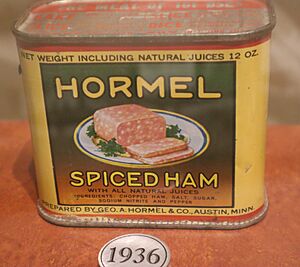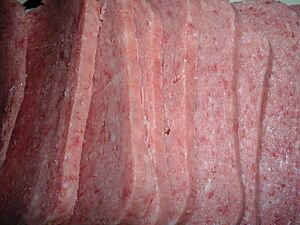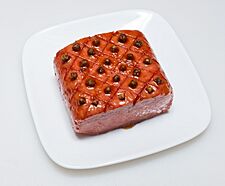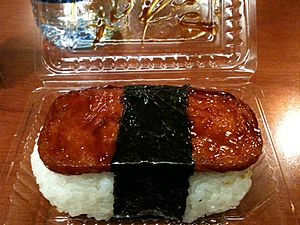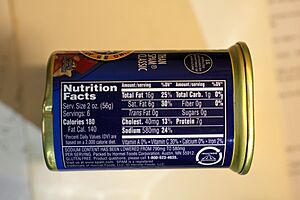Spam (food) facts for kids
Quick facts for kids 
Brand logo
|
|
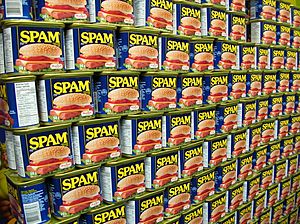
Products on display
|
|
| Owner | Hormel Foods Corporation |
|---|---|
| Introduced | 1937 |
| Markets | Worldwide |
Spam is a famous brand of lunch meat. It's a type of processed meat made from canned pork and ham. The company that makes Spam is called Hormel Foods Corporation, which is an American food company. Spam first came out in the United States in 1937. It became very popular around the world after it was used a lot during World War II. By 2003, Spam was sold in 41 countries and had trademarks in over 100 places across six continents.
Spam is mainly made from pork shoulder and ham. Other ingredients include salt, water, a special kind of modified potato starch (which helps hold it together), sugar, and sodium nitrite (which keeps it fresh). A natural jelly forms inside the cans during cooking. You can find Spam in different flavors, some with different meats, and also in "lite" (lighter) and lower-salt versions. Spam is already cooked, so it's safe to eat straight from the can. However, many people cook it more to make it taste even better.
Some people have wondered about how healthy Spam is. It has more than twice the recommended daily amount of fat compared to its protein. There are also questions about the health effects of salt and the preservatives used.
Spam has become a big part of popular culture. For example, there was a funny comedy sketch by Monty Python where the name "Spam" was repeated many times. This led to the word "Spam" being used to describe unwanted electronic messages, especially email. Sometimes, there are even festivals that celebrate Spam, like Spamarama in Austin, Texas.
Contents
History of Spam
Hormel first introduced Spam on July 5, 1937. The company wanted to sell more pork shoulder, which wasn't selling very well at the time.
A man named Ken Daigneau, whose brother worked for Hormel, won $100 in a competition to name the new product that year. Hormel says that only a few former company executives know the real meaning of the name. However, many people believe "Spam" is a shorter way of saying "spiced ham." Others think it might stand for "shoulder of pork and ham."
Spam During World War II
During World War II, it was hard to get fresh meat to soldiers fighting far away. Because of this, Spam became a very common food for U.S. soldiers. Soldiers sometimes joked about it, calling it "ham that didn't pass its physical" or "meatloaf without basic training." Over 150 million pounds of Spam were sent to the military before the war ended.
Some troops got tired of eating Spam all the time. They even wrote letters to Jay Hormel, the company president, complaining about it being at every meal. But even with these complaints, countries that were badly affected by the war and had very little food really appreciated Spam.
Spam was introduced to places like Guam, Hawaii, Okinawa, the Philippines, and other Pacific islands during and after World War II. It quickly became a part of the local diets there. Spam was also sold in the United Kingdom because of wartime rationing and the Lend-Lease Act. British Prime Minister Margaret Thatcher later called it a "wartime delicacy." Hormel also sent Spam to the Soviet Union as part of Allied aid. In his memories, Nikita Khrushchev, a Soviet leader, said, "Without Spam, we wouldn't have been able to feed our army."
The one billionth can of Spam was sold in 1959. By 2012, eight billion cans had been sold!
Spam Around the World
United States and Territories
In the U.S., Spam was popular because it was affordable, easy to find, and lasted a long time on the shelf. In the 1990s, about 3.8 cans of Spam were eaten every second in the United States. This added up to almost 122 million cans each year. Nearly 30% of American homes included Spam in their meals. People in different parts of the country saw it differently. Sometimes, it was linked to tough economic times because it cost less than other meats.
After World War II, Spam's role in the U.S. changed. It went from being a main source of protein to a side dish or an ingredient in things like sandwiches and eggs.
Spam sold in North America, South America, and Australia is made in Austin, Minnesota (also known as "Spam Town USA") and in Dubuque, Iowa. Austin, Minnesota even had a restaurant called "Johnny's SPAMarama Menu" that only served Spam dishes.
Hawaii's Love for Spam
People in Hawaii eat more Spam per person than anywhere else in the United States. They buy about 7 million cans of Spam every year! How people see Spam in Hawaii is very different from the mainland. Hawaiians sometimes call it "Portagee Steak."
A popular local dish in Hawaii is Spam musubi. This is cooked Spam placed on top of rice and wrapped with a strip of nori (seaweed). It's like a type of rice ball. You can find special kinds of Spam in Hawaii and Saipan that aren't sold elsewhere, like Honey Spam and Hot and Spicy Spam.
Hawaiian Burger King restaurants started serving Spam in 2007 to compete with local McDonald's restaurants, which also serve Spam. Spam is so popular in Hawaii that it's sometimes called "The Hawaiian Steak." There's even a yearly Spam festival on the island of Oahu each spring, called the "Waikiki Spam Jam." Local chefs and restaurants create new Spam dishes, which are then sold at a big street fair.
In 2017, Hawaii saw an increase in Spam thefts. Spam had always been a target for thieves in Hawaii, but the number of thefts grew, with many cases of Spam being stolen at once. This happened alongside more thefts of other store items like corned beef and liquor.
Guam and the Northern Marianas
In Guam, people eat about 16 cans of Spam per person each year. You can also find Spam on McDonald's menus there. The Spam Games also happen in Guam, where people taste and celebrate the best homemade Spam recipes.
Puerto Rico
Sandwich de Mezcla is a popular party food in Puerto Rico. It's made with Spam, Velveeta cheese, and pimientos blended into a spread, served between two slices of sandwich bread.
Europe
United Kingdom
After World War II, a company called Newforge Foods was allowed to make Spam in the U.K. at its factory in Liverpool. This continued until 1998, when production moved to the Danish Crown Group.
The United Kingdom has used Spam in different recipes. One example is Spam fritters, which are slices of Spam that are battered and deep-fried.
Asia
Philippines
In the Philippines, Spam is a very popular food and is seen as a cultural symbol. Spam arrived in the islands, like in Hawaii and Guam, because of World War II rationing. Spam is often eaten for breakfast with rice (usually garlic fried rice) and a fried egg. It's prepared in many ways, including fried, caramelized, served with sauces, or in sandwiches. It's also used in many Filipino fusion cuisine dishes, like Spam burgers, Spam spaghetti, and Spam nuggets.
Spam is popular with all kinds of people in the Philippines, no matter how much money they have. It's even given as a gift during holidays. There are at least ten different kinds of Spam available in the country. About 1.25 million kilograms of Spam are sold there every year. Because Filipinos love it so much, a special version with sugar and annatto, called Tocino-flavor Spam, was made for Filipinos living in the U.S. and Canada. After Typhoon Ondoy hit in 2009, Hormel Foods gave over 30,000 pounds of Spam to help with relief efforts.

China
In mainland China, Hormel decided to market Spam differently. They promoted it as a special, high-quality foreign food. They also changed the Spam recipe to have more meat to fit local Chinese tastes. Other food companies in China also make similar canned pork products called "luncheon meat."
Hong Kong
After World War II, meat was hard to find and expensive in Hong Kong. So, Spam became an easy and affordable choice. This canned meat has been added to dishes like macaroni with fried egg and Spam in chicken soup, egg and Spam sandwiches, and instant ramen. Today, Spam is still a common food for families with low to middle incomes in Hong Kong.
South Korea
Spam was sent to Korea after World War II, when many people there were very hungry. Spam became widely eaten in South Korea during the Korean War. U.S. soldiers in South Korea used Spam to trade for things, services, or information near their bases. Spam and other meats were sometimes secretly taken from U.S. military places for the local people. Its popularity led to the creation of Spam kimbap (a rice and vegetable roll wrapped in seaweed) in Korean cooking. Because there wasn't much fish or other traditional kimbap ingredients like kimchi, Spam was added to rice rolls with kimchi and cucumber and wrapped in seaweed. Spam is also a main ingredient in budae jjigae (부대찌ae; lit. army base stew), which is a spicy stew with different kinds of preserved meat or kimchi.
In South Korea, Spam (Korean: 스팸; RR: seupaem) is very popular with most people. By 2004, South Korea made and ate more Spam than any country except the United States. It's seen as a bit of a fancy dish and is often given as a gift for Korean New Year, along with cooking oil and seasonings.
Japan
In Okinawa, Japan, Spam is added to onigiri (rice balls) with eggs. It's also a main ingredient in the traditional Okinawan dish chanpurū. A Spam burger is sold by a local fast food chain called Jef. For Spam's 70th anniversary in 2007, special cans were sold in Japan because of its popularity, especially in Okinawa.
After the earthquake in March 2011, Spam sales in Japan went down. Hormel then focused more on China, though Hormel did promise to donate $100,000 and cans of Spam for relief efforts.
In early 2014, Burger King started offering a Spam and Cheese burger for breakfast.
What's in Spam?
The ingredients in Spam can be different depending on the flavor and where it's sold. "Spam Classic" contains pork with ham, salt, water, modified potato starch, sugar, and sodium nitrite. Sodium nitrite is a common preservative used in many processed meat products.
Here's a quick look at what's in Original Spam:
- It has about 310 calories per 100 grams.
- It contains 13 grams of protein.
- It has 27 grams of total fat, with 10 grams of saturated fat.
- It has 3 grams of carbohydrates.
- It has a lot of sodium, about 1369 mg.
- It also has some Vitamins and minerals like iron and zinc.
Different Kinds of Spam
The official Spam website lists many different flavors of Spam products. Besides different flavors, Spam is also sold in smaller cans than the usual 12-ounce (340 g) size. You can also buy Spam Singles, which are single, sandwich-sized slices of Spam Classic or Lite, sealed in special pouches.
See also
 In Spanish: Spam (alimento) para niños
In Spanish: Spam (alimento) para niños
- Back bacon
- Bologna sausage
- Chipped chopped ham
- Loco moco – A Hawaiian dish that sometimes uses Spam
- Pork roll
- Potted meat food product
- Prem – Another canned meat product similar to Spam
- Treet – Another canned meat product similar to Spam
- Tushonka – A canned, stewed meat


